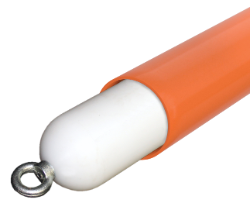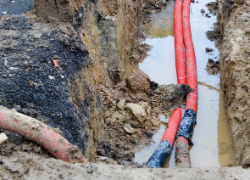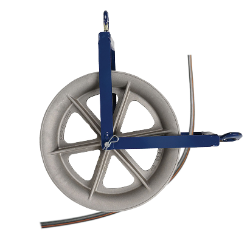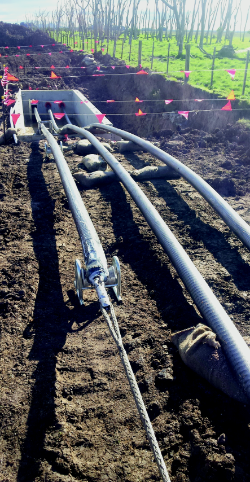Cable Hauling - Setting up for Success - Part 1
30 May, 2023
Cable hauling is a crucial part in the overall process of the installation and commissioning of communication, power, and utility cables. To ensure a smooth and efficient cable installation, it is essential to use the right tools and equipment that are fit for purpose. We will discuss the benefits of utilising Conduit Proving & Cleaning Equipment and the different types of Cable Rollers, Guides and Feeding sheaves in the cable installation process and why these items play a role in successful cable pulls.
Utilising quality cable hauling equipment offers numerous benefits for a successful cable installation process. The right equipment improves job site efficiency, eliminates cable damage, mitigates high Coefficients of Friction, and enhances overall safety outcomes. Simplifying the installation process with the right equipment in the right locations reduces setup time, labour costs and drives profitability benefit for cable hauling contractors.
Conduit Proving & Cleaning Equipment
Proper installation of conduits is essential for successful cable installation projects. Conduit proving and cleaning equipment play a crucial role in ensuring that conduits are free of debris, obstructions, and contaminants before cable installation. This step in the cable installation process reduces the potential to see an increase in the Coefficient of friction, thus reducing the risk of cable damage and improving safety and the efficiency of cable pulling.
Proving Mandrels
Proving mandrels, also known as conduit pigs, are cylindrical devices used to verify the integrity and cleanliness of conduits before cable installation. They are made of HDPE and are sized to typically 80-90% of the conduit inner wall providing a verification that no damage has occurred during any stage of the conduit install up to the backfilling of the conduit. When pulled through the conduit, proving mandrels dislodge and remove debris, identify obstructions, and ensure that the conduit is free of damage. Proving mandrels are essential for providing a conduit route verification and preventing cable damage during installation and ensuring efficient cable pulling.
Wire Brushes
Wire brushes are used to clean the interior walls of conduits, removing dirt and mud, rocks, rust/scale, and other contaminants that may cause increased pulling friction or damage to the cable sheath during install. These brushes are made of steel or stainless-steel bristles and are attached to a flexible shaft or rod that can be pulled through the conduit. Wire brushes are available in various sizes to accommodate different conduit diameters and can be used in conjunction with other cleaning equipment, such as rubber cleaners or lubricant spreaders, for a thorough conduit cleaning process.
Rubber Cleaners
Rubber cleaners, also known as conduit squeegees, are flexible cleaning devices designed to remove dirt, water and other debris from the interior of conduits, left in the conduit this material is known to cause increase to the cable pulls coefficient of friction. They are made of rubber and are sized to fit snugly within the conduit. Rubber cleaners can be pulled through the conduit using a rope or rodder, effectively wiping the conduit walls and removing debris. Rubber cleaners are often used in combination with wire brushes or proving mandrels to ensure the conduit is thoroughly cleaned.
Lubricant Spreaders
Lubricant spreaders, sometimes referred to as lubricant applicators or conduit lubricators, are devices used to apply cable pulling lubricant evenly throughout the interior of conduits. These spreaders normally consist of a soft rubber material attached to a shaft or rod. As the lubricant spreader is pulled through the conduit, it evenly distributes the lubricant along the conduit walls, reducing the coefficient of friction and in turn lowering the tension on the cable pull. This in combination with lubricating the cable means that you have a higher success rate of lowering your Coefficient of Friction. Lubricant spreaders are available in various sizes to accommodate different conduit diameters and can be used in conjunction with cleaning equipment, such as wire brushes or rubber cleaners.
Rollers, guides and feeding sheaves
Cable installation projects require specialised tools and equipment to ensure safe, efficient, and successful completion. Among these tools are various types of rollers and sheaves designed to guide, support, and protect cables during installation. Cables typically have limitations regarding the installed bending radius and these rollers ensure this parameter is not exceeded.
Cable Tray/Ladder Rollers
Cable tray rollers are designed for use in cable tray systems, which are support structures used to hold and organise electrical and communication cables usually within a building. These rollers are placed within the cable tray to facilitate smooth cable pulling and reduce friction between the cable and the tray. Cable tray rollers have a frame made of steel, with the rollers in an aluminium or nylon material and feature sealed bearings for smooth rotation.
Trench Rollers
Trench rollers are specifically designed for cable installation in trenches. They provide support and guidance for the cable as it is pulled through the trench on generally straight sections, reducing friction, and preventing damage to the cable's outer sheath by keeping out of the dirt. Trench rollers are made of heavy-duty materials, such as steel or aluminium with either an aluminium or Nylon rollers.
Feed-in Rollers
Feed-in rollers are used at the entry point of a cable installation project, where the cable is fed into the trench, pit, duct, or cable tray. These rollers help guide the cable into the installation area and provide initial support to prevent kinking or damage to the cable. Feed-in rollers may be designed as standalone units or integrated into other roller systems, such as trench or cable tray rollers.
Roller Guides
Roller guides are versatile tools that can be used in various cable installation scenarios. They are designed to guide and support the cable during installation, ensuring proper alignment and direction of cable, and reducing friction. Roller guides can be used in conjunction with other roller types, such as corner or curved rollers and feed-in rollers to provide comprehensive cable support.
Corner & Curved Rollers
Corner and curved rollers are specifically designed for projects with bends, corners, or changes of direction. These rollers help guide the cable around the bend, maintaining the proper bending radius and preventing damage to the cable's insulation and conductors. These rollers feature multiple sheaves to accommodate various cable bend radii. Corner and curved rollers can also be joined to adapt to various cable sizes and bend angles, ensuring a smooth and efficient cable pulling process.
Feeding Sheaves
Feeding sheaves are designed to support cables during installation when cables need to be pulled at an entry to duct or conduit. These sheaves consist of a grooved plate or a pulley that the cable passes through, guiding the cable into the duct and reducing friction as the cable is pulled. Feeding sheaves can be used in conjunction with other roller types in transition areas, such as cable tray rollers or trench rollers.
These are the typical rollers used in a cable haul, other rollers such as multi sheaves, hanging sheaves, hook sheaves and trapping rollers are also key products in the installation of cables. Each piece of equipment above is designed to guide, support, and protect cables during installation. By understanding the specific functions and applications of these rollers and sheaves, cable installers can select the most suitable tools for their projects improving project outcomes.
Planning your pull is a crucial step to ensuring the cable is installed correctly and safely. The use of the right, fit for purpose products provides benefits such as improving efficiency, reducing cable damage, ensuring smooth navigation through various installation environments, and enhancing overall safety. Ultimately this allows the installer to optimise the cable installation process, minimise potential issues, and ensure a reliable and long-lasting cable infrastructure. From Cable Tensions and Side Wall Pressure estimation software to all your cable installation tools, lubricants, sealants and equipment, TEN Group has the knowledge and products to ensure your cables pulls are safe and successful. Contact TEN: tengroup.com.au – sales@tengroup.com.au – 61 7 3212 8999
|








